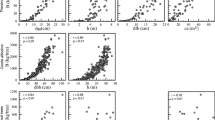Abstract
Allometric equations were generatedby harvesting tropical ash (Fraxinus uhdei(Wenzig) Lingelsh) trees growing on organic uplandssoils in the island of Hawaii. One of these equationswas used to estimate aboveground biomass of ten maturestands in the same area. Results indicated that theequation developed in situ, equations for white ash(Fraxinus americana L.), and generalizedfunctions for temperate and tropical forests, providedrelatively similar biomass estimates. Averagedifferences between biomass estimates from the testedequations (excluding the one for moist tropicalforests) and the function generated in situ rangedfrom 10 to 24%. One of the equations for white ashhad the lowest sum of residuals followed by thegeneralized equation for temperate forests. Theresults suggested commonality among biomass estimatesand, therefore, among relationships between treedimensions probably because most of the abovegroundtree biomass is in stem and branches, and thesecompartments are more stable than foliage mass. Equations to estimate commercial biomass and leaf areaof tropical ash are also provided.
Similar content being viewed by others
References
Avery, T.E. 1975. Natural Resources Measurements. McGraw-Hill Inc., New York, USA. 339 pp.
Baskerville, G.L. 1972. Use of logarithmic regression in the estimation of plant biomass. Can. J. For. Res. 2: 49-53.
Brown, S., Gillespie, A.J.R. and Lugo, A.E. 1989. Biomass estimation methods for tropical forests with application to forest inventory data. For. Sci. 35: 881-902.
Brown, S., Gillespie, A.J.R. and Lugo, A.E. 1991. Biomass of tropical forests of south and southeast Asia. Can. J. For. Res. 21: 111-117.
Brown, S. and Lugo, A.E. 1982. The storage and production of organic matter in tropical forests and their role in the global carbon cycle. Biotropica 14: 161-187.
Brown, S. and Lugo, A.E. 1992. Aboveground biomass estimates for tropical moist forests of the Brazilian Amazon. Interciencia 17: 8-18.
Crow, T.R. 1978. Common regressions to estimate tree biomass in tropical stands. For. Sci. 24: 110-114.
Feller, M.C. 1992. Generalized versus site-specific biomass regression equations for Pseudotsuga menziessi var. menziesii and Thuja plicata in Coastal British Columbia. Biores. Technol. 39: 9-16.
Gillespie, A.J.R., S. Brown and Lugo, A.E. 1992. Tropical forest biomass estimation from truncated stand tables. For. Ecol. Manage. 48: 69-87.
Harrington, R.A. and Fownes, J.H. 1993. Allometry and growth of planted versus coppice stands of four fast-growing tropical tree species. For. Ecol. Manage. 56: 315-327.
Kira, T. and Shidei, T. 1967. Primary production and turnover of organic matter in different forest ecosystems of the western Pacific. Japanese J. Ecol. 17: 70-87.
Madgwick, H.A.I., D.J. Frederick and Thompson, T.D. 1991. Biomass relationships in stands of Eucalyptus species. Biores. Technol. 37: 85-91.
Nowak, D.J. 1996. Estimating leaf area and leaf biomass of open-grown deciduous urban trees. For. Sci. 42: 504-507.
Overman, J.P.M., Witte, H.J.L. and Saldarriaga, J.G. 1994. Evaluation of regression models for above-ground biomass determination in Amazon rainforest. J. Trop. Ecol. 10: 207-218.
Pastor, J., Aber, J.D. and Melillo, J.M. 1984. Biomass prediction using generalized allometric regressions for some Northeast tree species. For. Ecol. Manage. 7: 265-274.
Perala, D. and Alban, D.H. 1994. Allometric biomass estimates for aspen-dominated ecosystems in the upper Great Lakes. USDA Forest Serv., NC Forest Exp. Sta., St. Paul, MN. Res. Paper NC-314.
Quellet, D. 1983. Biomass production equations for twelve commercial species in Quebec. Can. For. Serv. Inf. Rep. LAU-X-62E.
Ranger, J. and Nys, C. 1996. Biomass and nutrient content of extensively and intensively managed coppice stands. Forestry 69: 91-110.
Saldarriaga, J.G., West, D.C., Tharp, M.L. and Uhl, C. 1988. Long-term chronosequence of forest succession in the Upper Rio Negro of Colombia and Venezuela. J. Ecol. 76: 938-958.
Schroeder, P., Brown, S., Mo, J., Birdsey, R. and Cieszewski, C. 1997. Biomass estimation for temperate broadleaf forests of the United States using inventory data. For. Sci. 43: 424-434.
Shapiro, S.S. and Francia, R.S. 1972. An approximate analysis of variance test for normality. J. Am. Stat. Asoc. 67: 215-216.
Singh, T. 1986. Generalizing biomass equations for the boreal forest region of west-central Canada. For. Ecol. Manage. 17: 97-107.
Ter-Mikaelian, M.T. and Korzukhin, M.D. 1997. Biomass equations for sixty-five North American tree species. For. Ecol. Manage. 97: 1-24.
Turner, D.P., Koerper, G.J., Harmon, M.E. and Lee, J.J. 1995. A carbon budget for forests of the coterminous United States. Ecol. App. 5: 421-436.
Author information
Authors and Affiliations
Rights and permissions
About this article
Cite this article
Ares, A., Fownes, J.H. Comparisons between generalized and specific tree biomass functions as applied to tropical ash (Fraxinus uhdei). New Forests 20, 277–286 (2000). https://doi.org/10.1023/A:1006766529550
Issue Date:
DOI: https://doi.org/10.1023/A:1006766529550




